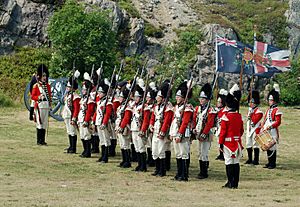United Irish Uprising in Newfoundland facts for kids
Quick facts for kids United Irish Uprising in Newfoundland |
|||||||
|---|---|---|---|---|---|---|---|
 Reenactors portraying the Royal Newfoundland Regiment, a unit involved in the uprising |
|||||||
|
|||||||
| Belligerents | |||||||
| Mutineers | |||||||
| Commanders and leaders | |||||||
| James Murphy Sergeant Kelly |
|||||||
| Strength | |||||||
| British garrison in Newfoundland | 19 mutineers | ||||||
| Casualties and losses | |||||||
| None | 8 executed 5 transported |
||||||
The United Irish Uprising in Newfoundland was a failed attempt by Irish soldiers to rebel against their British commanders. This event happened in St. John's, Newfoundland, on April 24, 1800. The authorities believed it was inspired by the Society of United Irishmen and their rebellion in Ireland just two years earlier.
Why the Uprising Happened
Irish Immigration and Tensions
In 1798, a large rebellion against British rule in Ireland failed. Around the same time, many Irish people were moving to Newfoundland. This movement increased even more after the rebellion. By 1800, about two-thirds of the people in St. John's were Irish. Many Irish soldiers also served in the British army there.
Rumors of a Secret Plan
In April 1800, rumors began to spread in St. John's. People heard that up to 400 Irish individuals, including soldiers, had formed a secret society. These soldiers were part of the Newfoundland garrison, which included units like the Royal Newfoundland Regiment. They were thought to be inspired by the Society of United Irishmen. The rumors claimed they had sworn oaths to plan a mutiny.
The Alleged Plot
It was believed that more than 80 Irish soldiers planned to meet. Their meeting point was the gunpowder magazine at Fort Townshend. The plan was to attack their officers and important townspeople on April 20.
The Uprising Begins
Military Response to Rumors
Because of these rumors, John Skerrett, the highest-ranking officer, took action. He ordered the Royal Newfoundland Fencibles to gather for a parade on April 20. This was a way to keep an eye on the soldiers.
The Night of the Mutiny
On the night of April 24, 19 Irish soldiers gathered at the Fort Townshend gunpowder magazine. These soldiers included 11 fencibles and 8 artillerymen. They were led by two men named James Murphy and Sergeant Kelly.
Missing Reinforcements
The mutineers found that 30 other soldiers from Fort William could not join them. Their commander, Thomas Skinner, had kept them from leaving. He had temporarily held them back because of the rumors.
Mutineers Flee
News of the attempted mutiny spread quickly. The 19 mutineers realized their plan was discovered. They decided to flee into the countryside to escape.
Church Leader's Warning
Fr. James Louis O’Donel, the Catholic Bishop of St. John’s, heard about the plot. He told his priests to "oppose with all the means in their power all plotters conspirators." He warned that the goal of this conspiracy was to "dissolve all bonds, all laws by which society is held together."
Aftermath of the Uprising
Capture and Punishment
Most of the mutineers were quickly caught by soldiers from the garrison. This happened within a few weeks. However, James Murphy and Sergeant Kelly were never found. Four mutineers who gave information about their fellow soldiers were not punished.
Sentences for the Mutineers
John Skerrett ordered five mutineers to be put to death by hanging. This happened near the gunpowder magazine. The remaining eight mutineers were sent to Halifax, Nova Scotia. There, the Duke of Kent sentenced three of them to death. The other five were sent away to another place as punishment.
Impact on Newfoundland
Historian John Edward FitzGerald noted the importance of this uprising. It was the only rebellion that British officials directly linked to the one in Ireland. The uprising showed that the Irish in Newfoundland were willing to challenge the government. Britain worried that this might not be the last time. Because of this, British officials in the Colonial Office started to see Newfoundland as a place with potential for political trouble.
Reasons for the Mutiny
It is still not fully clear why the mutiny happened. FitzGerald wrote that the leaders' goals were never made clear. It is also uncertain if they were truly members of the United Irishmen. Bishop O'Donel thought the soldiers wanted to steal and escape to America.
Harsh Conditions
Another idea is that the uprising was not just a political plot. It might have been an act of desperation. The soldiers faced very difficult living conditions and harsh treatment from their officers. Many Irish reserve soldiers were forced to stay on duty. This meant they could not go fishing, which was how they supported their families in St. John's.
Awareness of Irish Rights
The Irish in Newfoundland would have known about the fight for equal rights in their homeland. There were reports of communication with United Irishmen in Ireland before the 1798 rebellion. Pamphlets by Thomas Paine were also circulating in St. John's. Even during the war with France, many young men from Waterford came to the island for fishing. Some of these were defeated rebels, who were said to have "added fuel to the fire" of local complaints.
See also
- List of conflicts in Canada
- List of Irish uprisings

